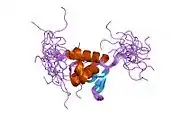COPS4
COP9 signalosome complex subunit 4 is a protein that in humans is encoded by the COPS4 gene.[5][6]
This gene encodes one of eight subunits composing COP9 signalosome, a highly conserved protein complex that functions as an important regulator in multiple signaling pathways. The structure and function of COP9 signalosome is similar to that of the 19S regulatory particle of 26S proteasome. COP9 signalosome has been shown to interact with SCF-type E3 ubiquitin ligases and act as a positive regulator of E3 ubiquitin ligases.[6]
References
- GRCh38: Ensembl release 89: ENSG00000138663 - Ensembl, May 2017
- GRCm38: Ensembl release 89: ENSMUSG00000035297 - Ensembl, May 2017
- "Human PubMed Reference:". National Center for Biotechnology Information, U.S. National Library of Medicine.
- "Mouse PubMed Reference:". National Center for Biotechnology Information, U.S. National Library of Medicine.
- Wei N, Tsuge T, Serino G, Dohmae N, Takio K, Matsui M, Deng XW (Oct 1998). "The COP9 complex is conserved between plants and mammals and is related to the 26S proteasome regulatory complex". Curr Biol. 8 (16): 919–924. doi:10.1016/S0960-9822(07)00372-7. PMID 9707402. S2CID 13873982.
- "Entrez Gene: COPS4 COP9 constitutive photomorphogenic homolog subunit 4 (Arabidopsis)".
External links
- Human COPS4 genome location and COPS4 gene details page in the UCSC Genome Browser.
Further reading
- Schwechheimer C, Deng XW (2001). "COP9 signalosome revisited: a novel mediator of protein degradation". Trends Cell Biol. 11 (10): 420–426. doi:10.1016/S0962-8924(01)02091-8. PMID 11567875.
- Wolf DA, Zhou C, Wee S (2004). "The COP9 signalosome: an assembly and maintenance platform for cullin ubiquitin ligases?". Nat. Cell Biol. 5 (12): 1029–1033. doi:10.1038/ncb1203-1029. PMID 14647295. S2CID 37458780.
- Maruyama K, Sugano S (1994). "Oligo-capping: a simple method to replace the cap structure of eukaryotic mRNAs with oligoribonucleotides". Gene. 138 (1–2): 171–174. doi:10.1016/0378-1119(94)90802-8. PMID 8125298.
- Suzuki Y, Yoshitomo-Nakagawa K, Maruyama K, et al. (1997). "Construction and characterization of a full length-enriched and a 5'-end-enriched cDNA library". Gene. 200 (1–2): 149–156. doi:10.1016/S0378-1119(97)00411-3. PMID 9373149.
- Seeger M, Kraft R, Ferrell K, et al. (1998). "A novel protein complex involved in signal transduction possessing similarities to 26S proteasome subunits". FASEB J. 12 (6): 469–78. doi:10.1096/fasebj.12.6.469. PMID 9535219. S2CID 25424324.
- Sanger Centre, The; Washington University Genome Sequencing Cente, The (1999). "Toward a complete human genome sequence". Genome Res. 8 (11): 1097–108. doi:10.1101/gr.8.11.1097. PMID 9847074.
- Naumann M, Bech-Otschir D, Huang X, et al. (2000). "COP9 signalosome-directed c-Jun activation/stabilization is independent of JNK" (PDF). J. Biol. Chem. 274 (50): 35297–35300. doi:10.1074/jbc.274.50.35297. PMID 10585392. S2CID 27417298.
- Cohen H, Azriel A, Cohen T, et al. (2001). "Interaction between Interferon Consensus Sequence-binding protein and COP9/signalosome subunit CSN2 (Trip15). A possible link between interferon regulatory factor signaling and the COP9/signalosome". J. Biol. Chem. 275 (50): 39081–39089. doi:10.1074/jbc.M004900200. PMID 10991940.
- Tsuge T, Matsui M, Wei N (2001). "The subunit 1 of the COP9 signalosome suppresses gene expression through its N-terminal domain and incorporates into the complex through the PCI domain". J. Mol. Biol. 305 (1): 1–9. doi:10.1006/jmbi.2000.4288. PMID 11114242.
- Bech-Otschir D, Kraft R, Huang X, et al. (2001). "COP9 signalosome-specific phosphorylation targets p53 to degradation by the ubiquitin system". EMBO J. 20 (7): 1630–1639. doi:10.1093/emboj/20.7.1630. PMC 145508. PMID 11285227.
- Lyapina S, Cope G, Shevchenko A, et al. (2001). "Promotion of NEDD-CUL1 conjugate cleavage by COP9 signalosome". Science. 292 (5520): 1382–1385. doi:10.1126/science.1059780. PMID 11337588. S2CID 14224920.
- Peyrl A, Weitzdoerfer R, Gulesserian T, et al. (2003). "Aberrant expression of signaling-related proteins 14-3-3 gamma and RACK1 in fetal Down syndrome brain (trisomy 21)". Electrophoresis. 23 (1): 152–7. doi:10.1002/1522-2683(200201)23:1<152::AID-ELPS152>3.0.CO;2-T. PMID 11824616.
- Hoareau Alves K, Bochard V, Réty S, Jalinot P (2002). "Association of the mammalian proto-oncoprotein Int-6 with the three protein complexes eIF3, COP9 signalosome and 26S proteasome". FEBS Lett. 527 (1–3): 15–21. doi:10.1016/S0014-5793(02)03147-2. PMID 12220626. S2CID 39308598.
- Strausberg RL, Feingold EA, Grouse LH, et al. (2003). "Generation and initial analysis of more than 15,000 full-length human and mouse cDNA sequences". Proc. Natl. Acad. Sci. U.S.A. 99 (26): 16899–16903. doi:10.1073/pnas.242603899. PMC 139241. PMID 12477932.
- Serino G, Su H, Peng Z, et al. (2003). "Characterization of the last subunit of the Arabidopsis COP9 signalosome: implications for the overall structure and origin of the complex". Plant Cell. 15 (3): 719–731. doi:10.1105/tpc.009092. PMC 150025. PMID 12615944.
- Uhle S, Medalia O, Waldron R, et al. (2003). "Protein kinase CK2 and protein kinase D are associated with the COP9 signalosome". EMBO J. 22 (6): 1302–1312. doi:10.1093/emboj/cdg127. PMC 151059. PMID 12628923.
- Groisman R, Polanowska J, Kuraoka I, et al. (2003). "The ubiquitin ligase activity in the DDB2 and CSA complexes is differentially regulated by the COP9 signalosome in response to DNA damage". Cell. 113 (3): 357–367. doi:10.1016/S0092-8674(03)00316-7. PMID 12732143. S2CID 11639677.
This article is issued from Wikipedia. The text is licensed under Creative Commons - Attribution - Sharealike. Additional terms may apply for the media files.






